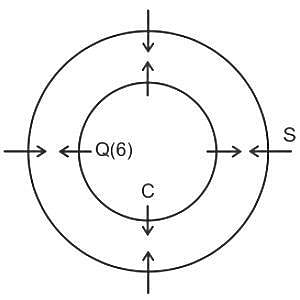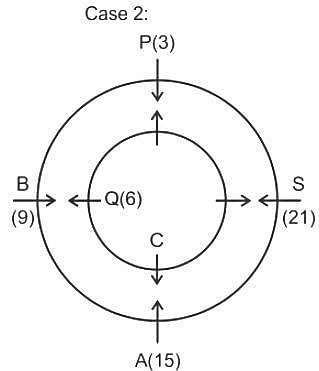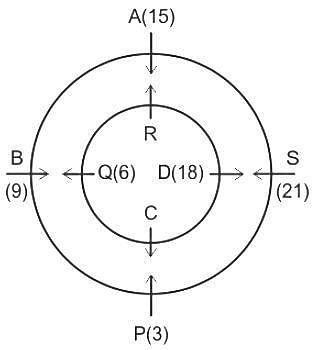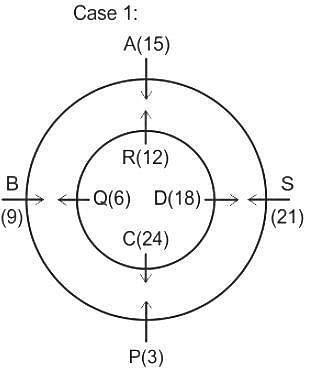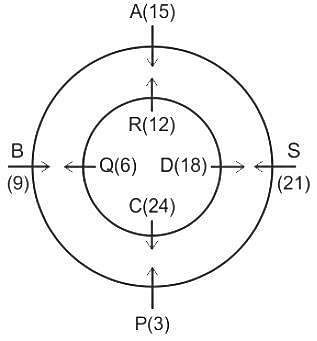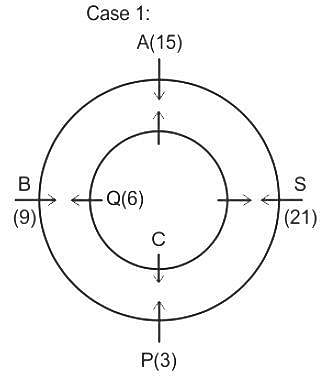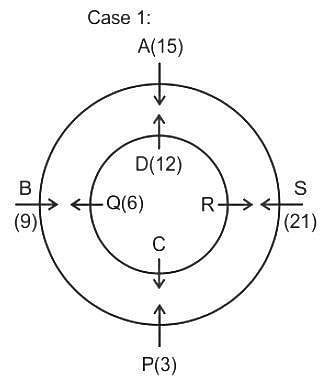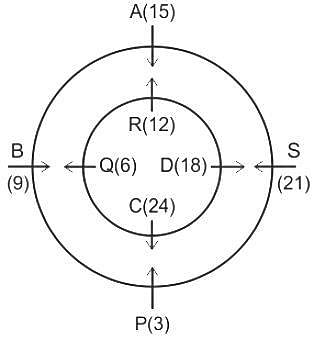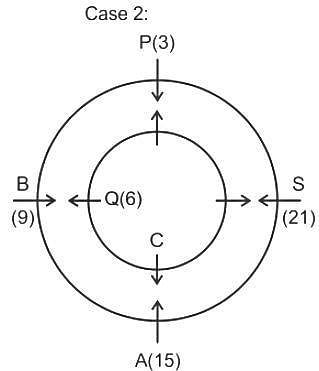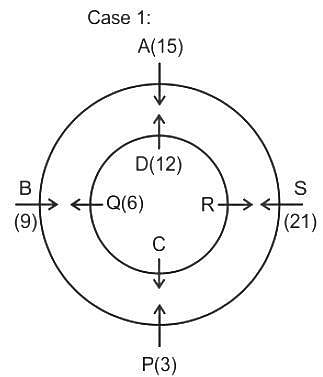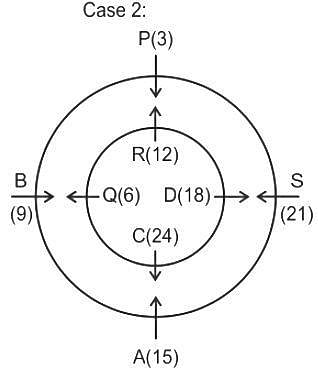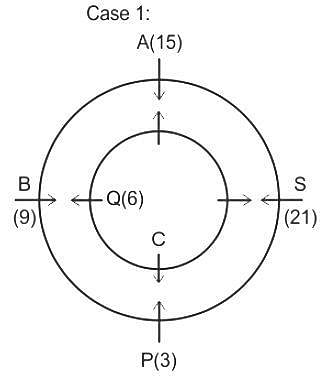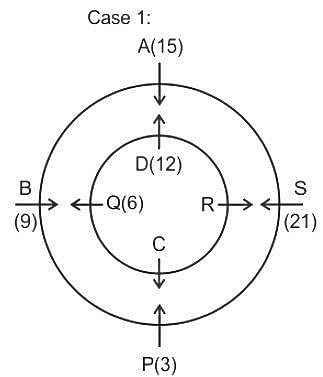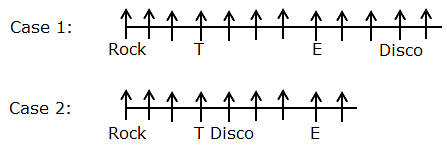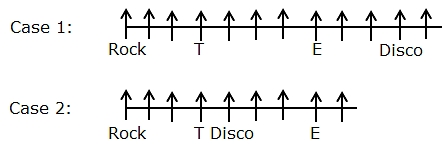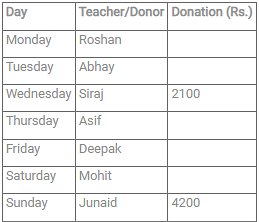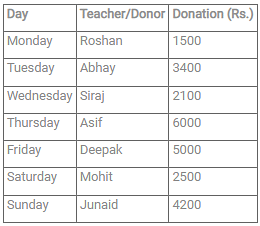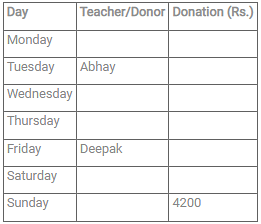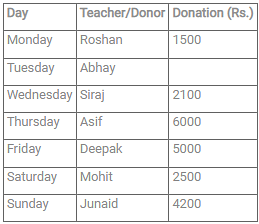IBPS Clerk Mains Mock Test - 2 - Banking Exams MCQ
30 Questions MCQ Test - IBPS Clerk Mains Mock Test - 2
Directions: Study the following information carefully and answer the given questions given below:
Eight persons P, Q, R, S, A, B, C, and D are sitting around a circular table but not necessarily in the same order. There is also a bigger circle circumscribing the smaller circle. Four persons are sitting in the smaller circle and remaining four persons are sitting in the bigger circle, facing each other. Persons sitting in the smaller circle are facing away from the centre and persons sitting in the bigger circle are facing towards the centre of the circle. The number of assignments they have to submit is different and are multiple of 3 viz, 3, 6, 9, 12, 15,18, 21, and 24. Q is sitting in the smaller circle, third to the left of C, and have to submit 6 assignments. A sit second to the left of P, and have to submit five times more submit than P. Number of assignments A and B have to submit together is three more than to the number of assignments submitted by S. S faces the person who is an immediate neighbor of C, but not the one who have submitted less than 10 assignments. B and P are immediate neighbor of each other. D faces the person who have to submit three more assignments than D. R has to submit half number of assignments than C. The person who sits on the immediate right of B have to submit the number of assignments which is square root of the number of assignments B has to submit.
Q. Who among the following has to submit 24 assignments?
Directions: Study the following information carefully and answer the given questions given below:
Eight persons P, Q, R, S, A, B, C, and D are sitting around a circular table but not necessarily in the same order. There is also a bigger circle circumscribing the smaller circle. Four persons are sitting in the smaller circle and remaining four persons are sitting in the bigger circle, facing each other. Persons sitting in the smaller circle are facing away from the centre and persons sitting in the bigger circle are facing towards the centre of the circle. The number of assignments they have to submit is different and are multiple of 3 viz, 3, 6, 9, 12, 15,18, 21, and 24. Q is sitting in the smaller circle, third to the left of C, and have to submit 6 assignments. A sit second to the left of P, and have to submit five times more submit than P. Number of assignments A and B have to submit together is three more than to the number of assignments submitted by S. S faces the person who is an immediate neighbor of C, but not the one who have submitted less than 10 assignments. B and P are immediate neighbor of each other. D faces the person who have to submit three more assignments than D. R has to submit half number of assignments than C. The person who sits on the immediate right of B have to submit the number of assignments which is square root of the number of assignments B has to submit.
Q. Who faces A?
| 1 Crore+ students have signed up on EduRev. Have you? Download the App |
Directions: Study the following information carefully and answer the given questions given below:
Eight persons P, Q, R, S, A, B, C, and D are sitting around a circular table but not necessarily in the same order. There is also a bigger circle circumscribing the smaller circle. Four persons are sitting in the smaller circle and remaining four persons are sitting in the bigger circle, facing each other. Persons sitting in the smaller circle are facing away from the centre and persons sitting in the bigger circle are facing towards the centre of the circle. The number of assignments they have to submit is different and are multiple of 3 viz, 3, 6, 9, 12, 15,18, 21, and 24. Q is sitting in the smaller circle, third to the left of C, and have to submit 6 assignments. A sit second to the left of P, and have to submit five times more submit than P. Number of assignments A and B have to submit together is three more than to the number of assignments submitted by S. S faces the person who is an immediate neighbor of C, but not the one who have submitted less than 10 assignments. B and P are immediate neighbor of each other. D faces the person who have to submit three more assignments than D. R has to submit half number of assignments than C. The person who sits on the immediate right of B have to submit the number of assignments which is square root of the number of assignments B has to submit.
Q. What is the product of the number of assignments submitted by D and B together?
Directions: Study the following information carefully and answer the given questions given below:
Eight persons P, Q, R, S, A, B, C, and D are sitting around a circular table but not necessarily in the same order. There is also a bigger circle circumscribing the smaller circle. Four persons are sitting in the smaller circle and remaining four persons are sitting in the bigger circle, facing each other. Persons sitting in the smaller circle are facing away from the centre and persons sitting in the bigger circle are facing towards the centre of the circle. The number of assignments they have to submit is different and are multiple of 3 viz, 3, 6, 9, 12, 15,18, 21, and 24. Q is sitting in the smaller circle, third to the left of C, and have to submit 6 assignments. A sit second to the left of P, and have to submit five times more submit than P. Number of assignments A and B have to submit together is three more than to the number of assignments submitted by S. S faces the person who is an immediate neighbor of C, but not the one who have submitted less than 10 assignments. B and P are immediate neighbor of each other. D faces the person who have to submit three more assignments than D. R has to submit half number of assignments than C. The person who sits on the immediate right of B have to submit the number of assignments which is square root of the number of assignments B has to submit.
Q. Four of the five are alike in a certain way and so form a group. Which of the following does not belong to the group?
Directions: Study the following information carefully and answer the given questions given below:
Eight persons P, Q, R, S, A, B, C, and D are sitting around a circular table but not necessarily in the same order. There is also a bigger circle circumscribing the smaller circle. Four persons are sitting in the smaller circle and remaining four persons are sitting in the bigger circle, facing each other. Persons sitting in the smaller circle are facing away from the centre and persons sitting in the bigger circle are facing towards the centre of the circle. The number of assignments they have to submit is different and are multiple of 3 viz, 3, 6, 9, 12, 15,18, 21, and 24. Q is sitting in the smaller circle, third to the left of C, and have to submit 6 assignments. A sit second to the left of P, and have to submit five times more submit than P. Number of assignments A and B have to submit together is three more than to the number of assignments submitted by S. S faces the person who is an immediate neighbor of C, but not the one who have submitted less than 10 assignments. B and P are immediate neighbor of each other. D faces the person who have to submit three more assignments than D. R has to submit half number of assignments than C. The person who sits on the immediate right of B have to submit the number of assignments which is square root of the number of assignments B has to submit.
Q. Who sits on the immediate left of the person who faces the person who have submitted 6 assignments?
Study the following information carefully and answer the questions given below.
Words and numbers arrangement machines when given an input line of numbers rearrange them following a particular rule in each step. The following is an illustration of input and rearrangement.
Input: Clock 56 Trend 88 Lunch March 72 96 12 Which
Step I: M@rch 12 Clock 56 Trend 88 Lunch 72 96 Which
Step II: M@rch 12 Clock 88 Lunch 72 96 Which Tr#nd 56
Step III: M@rch 12 Wh$ch 72 Clock 88 Lunch 96 Tr#nd 56
Step IV: M@rch 12 Wh$ch 72 Lunch 96 Cl%ck 88 Tr#nd 56
Step V: M@rch 12 Wh$ch 72 L&nch 96 Cl%ck 88 Tr#nd 56
Step V is the last step.
Input: Thing 26 79 Watch Study Press 67 18 World 33
Q. Which of the following element is second from the left end of step III?
Study the following information carefully and answer the questions given below.
Words and numbers arrangement machines when given an input line of numbers rearrange them following a particular rule in each step. The following is an illustration of input and rearrangement.
Input: Clock 56 Trend 88 Lunch March 72 96 12 Which
Step I: M@rch 12 Clock 56 Trend 88 Lunch 72 96 Which
Step II: M@rch 12 Clock 88 Lunch 72 96 Which Tr#nd 56
Step III: M@rch 12 Wh$ch 72 Clock 88 Lunch 96 Tr#nd 56
Step IV: M@rch 12 Wh$ch 72 Lunch 96 Cl%ck 88 Tr#nd 56
Step V: M@rch 12 Wh$ch 72 L&nch 96 Cl%ck 88 Tr#nd 56
Step V is the last step.
Input: Thing 26 79 Watch Study Press 67 18 World 33
Q. How many elements are there to the right of “67” in step IV?
Study the following information carefully and answer the questions given below.
Words and numbers arrangement machines when given an input line of numbers rearrange them following a particular rule in each step. The following is an illustration of input and rearrangement.
Input: Clock 56 Trend 88 Lunch March 72 96 12 Which
Step I: M@rch 12 Clock 56 Trend 88 Lunch 72 96 Which
Step II: M@rch 12 Clock 88 Lunch 72 96 Which Tr#nd 56
Step III: M@rch 12 Wh$ch 72 Clock 88 Lunch 96 Tr#nd 56
Step IV: M@rch 12 Wh$ch 72 Lunch 96 Cl%ck 88 Tr#nd 56
Step V: M@rch 12 Wh$ch 72 L&nch 96 Cl%ck 88 Tr#nd 56
Step V is the last step.
Input: Thing 26 79 Watch Study Press 67 18 World 33
Q. In which of the following step the number of elements in between ‘W@tch’ and ‘79’ is maximum?
Study the following information carefully and answer the questions given below.
Words and numbers arrangement machines when given an input line of numbers rearrange them following a particular rule in each step. The following is an illustration of input and rearrangement.
Input: Clock 56 Trend 88 Lunch March 72 96 12 Which
Step I: M@rch 12 Clock 56 Trend 88 Lunch 72 96 Which
Step II: M@rch 12 Clock 88 Lunch 72 96 Which Tr#nd 56
Step III: M@rch 12 Wh$ch 72 Clock 88 Lunch 96 Tr#nd 56
Step IV: M@rch 12 Wh$ch 72 Lunch 96 Cl%ck 88 Tr#nd 56
Step V: M@rch 12 Wh$ch 72 L&nch 96 Cl%ck 88 Tr#nd 56
Step V is the last step.
Input: Thing 26 79 Watch Study Press 67 18 World 33
Q. Which of the following is step III?
Direction: In a number system there are symbols namely @ and #. ‘0’ is represented by ‘@’and ‘1’ is represented by ‘#’. Subsequently,
‘2’ is represented by ‘#@’.
‘3’ is represented by ‘##’
‘4’ is represented by ‘#@@’
‘5’ is represented by ‘#@#’
‘6’ is represented by ‘##@’
Based, on the above pattern, answer the question that follows-
Q. Which of the following will represent code for ‘23’?
Direction: In a number system there are symbols namely @ and #. ‘0’ is represented by ‘@’and ‘1’ is represented by ‘#’. Subsequently,
‘2’ is represented by ‘#@’.
‘3’ is represented by ‘##’
‘4’ is represented by ‘#@@’
‘5’ is represented by ‘#@#’
‘6’ is represented by ‘##@’
Based, on the above pattern, answer the question that follows-
Q. Which of the following will represent code for ‘49?
Direction: In a number system there are symbols namely @ and #. ‘0’ is represented by ‘@’and ‘1’ is represented by ‘#’. Subsequently,
‘2’ is represented by ‘#@’.
‘3’ is represented by ‘##’
‘4’ is represented by ‘#@@’
‘5’ is represented by ‘#@#’
‘6’ is represented by ‘##@’
Based, on the above pattern, answer the question that follows-
Q. Which of the following will be represented by #@##@?
Study the following information carefully and answer the questions given below.
Certain number of persons are sitting in a linear row facing the north direction and some of them sing different songs. Only two persons sit between E and the one who sings Disco but none of them sits at the end of the row. The number of persons sitting between E and the one who sings Disco is one less than the number of persons sitting between E and T, who sits third to the right of the one who sings Rock. E doesn’t sit adjacent to the one who sings Rock. T sits exactly in the middle of the one who sings Disco and M, who sits fifth to the right of the one who sings Folk. As many persons sit between M and the one who sings Rock as to the left of the one who sings Folk. Only three persons sit between S and the one who sings Jazz, who sits three places away from the one who sings Folk. More than one person sits between S and M. As many persons sit between the one who sings Jazz and M as between T and K, who sits fifth to the left of the one who sings Pop. Not more than five persons sit to the right of the one who sings Pop. Not more than four persons are seated between the one who sings pop and disco.
Q. How many persons are sitting in the row?
Study the following information carefully and answer the questions given below.
Certain number of persons are sitting in a linear row facing the north direction and some of them sing different songs. Only two persons sit between E and the one who sings Disco but none of them sits at the end of the row. The number of persons sitting between E and the one who sings Disco is one less than the number of persons sitting between E and T, who sits third to the right of the one who sings Rock. E doesn’t sit adjacent to the one who sings Rock. T sits exactly in the middle of the one who sings Disco and M, who sits fifth to the right of the one who sings Folk. As many persons sit between M and the one who sings Rock as to the left of the one who sings Folk. Only three persons sit between S and the one who sings Jazz, who sits three places away from the one who sings Folk. More than one person sits between S and M. As many persons sit between the one who sings Jazz and M as between T and K, who sits fifth to the left of the one who sings Pop. Not more than five persons sit to the right of the one who sings Pop. Not more than four persons are seated between the one who sings pop and disco.
Q. What is the position of T with respect to the one who sings Pop?
Study the following information carefully and answer the questions given below.
Certain number of persons are sitting in a linear row facing the north direction and some of them sing different songs. Only two persons sit between E and the one who sings Disco but none of them sits at the end of the row. The number of persons sitting between E and the one who sings Disco is one less than the number of persons sitting between E and T, who sits third to the right of the one who sings Rock. E doesn’t sit adjacent to the one who sings Rock. T sits exactly in the middle of the one who sings Disco and M, who sits fifth to the right of the one who sings Folk. As many persons sit between M and the one who sings Rock as to the left of the one who sings Folk. Only three persons sit between S and the one who sings Jazz, who sits three places away from the one who sings Folk. More than one person sits between S and M. As many persons sit between the one who sings Jazz and M as between T and K, who sits fifth to the left of the one who sings Pop. Not more than five persons sit to the right of the one who sings Pop. Not more than four persons are seated between the one who sings pop and disco.
Q. As many persons sit between the one who sings Folk and K as between ______.
Study the following information carefully and answer the questions given below.
Certain number of persons are sitting in a linear row facing the north direction and some of them sing different songs. Only two persons sit between E and the one who sings Disco but none of them sits at the end of the row. The number of persons sitting between E and the one who sings Disco is one less than the number of persons sitting between E and T, who sits third to the right of the one who sings Rock. E doesn’t sit adjacent to the one who sings Rock. T sits exactly in the middle of the one who sings Disco and M, who sits fifth to the right of the one who sings Folk. As many persons sit between M and the one who sings Rock as to the left of the one who sings Folk. Only three persons sit between S and the one who sings Jazz, who sits three places away from the one who sings Folk. More than one person sits between S and M. As many persons sit between the one who sings Jazz and M as between T and K, who sits fifth to the left of the one who sings Pop. Not more than five persons sit to the right of the one who sings Pop. Not more than four persons are seated between the one who sings pop and disco.
Q. If only the persons names are known arranged in the reverse alphabetical order on the respective occupied seats from left to right, then how many persons remain unchanged in their position?
Study the following information carefully and answer the questions given below.
Certain number of persons are sitting in a linear row facing the north direction and some of them sing different songs. Only two persons sit between E and the one who sings Disco but none of them sits at the end of the row. The number of persons sitting between E and the one who sings Disco is one less than the number of persons sitting between E and T, who sits third to the right of the one who sings Rock. E doesn’t sit adjacent to the one who sings Rock. T sits exactly in the middle of the one who sings Disco and M, who sits fifth to the right of the one who sings Folk. As many persons sit between M and the one who sings Rock as to the left of the one who sings Folk. Only three persons sit between S and the one who sings Jazz, who sits three places away from the one who sings Folk. More than one person sits between S and M. As many persons sit between the one who sings Jazz and M as between T and K, who sits fifth to the left of the one who sings Pop. Not more than five persons sit to the right of the one who sings Pop. Not more than four persons are seated between the one who sings pop and disco.
Q. Four of the following five are alike in a certain way and hence form a group. Find the one that doesn’t belong to that group.
Directions: In a certain coding system,
In the following questions, the symbols @, ©, #, $ and ⋆ are used with the following meaning illustrated.
‘P © Q’ means ‘P is not smaller than Q’.
‘P ⋆ Q’ means ‘P is neither greater than nor smaller than Q’.
‘P @ Q’ means ‘P is neither greater than nor equal to Q’.
‘P # Q’ means ‘P is neither smaller than nor equal to Q’.
‘P % Q’ means ‘P is not greater than Q’.
Based on the information provided above, answer the following questions.
Statement: U * V, V @ W, W % Z, Z@Y, Y*X
Conclusions:
I. Z @ U
II. W # U
III. Z # V
Directions: In a certain coding system,
In the following questions, the symbols @, ©, #, $ and ⋆ are used with the following meaning illustrated.
‘P © Q’ means ‘P is not smaller than Q’.
‘P ⋆ Q’ means ‘P is neither greater than nor smaller than Q’.
‘P @ Q’ means ‘P is neither greater than nor equal to Q’.
‘P # Q’ means ‘P is neither smaller than nor equal to Q’.
‘P % Q’ means ‘P is not greater than Q’.
Based on the information provided above, answer the following questions.
Statement: N % R, R # Q, Q © S, S*T, T@U
Conclusions:
I. N @ Q
II. R © S
III. S @ R
Directions: In a certain coding system,
In the following questions, the symbols @, ©, #, $ and ⋆ are used with the following meaning illustrated.
‘P © Q’ means ‘P is not smaller than Q’.
‘P ⋆ Q’ means ‘P is neither greater than nor smaller than Q’.
‘P @ Q’ means ‘P is neither greater than nor equal to Q’.
‘P # Q’ means ‘P is neither smaller than nor equal to Q’.
‘P % Q’ means ‘P is not greater than Q’.
Based on the information provided above, answer the following questions.
Statements: A © B, B # C, C ⋆ D, D @ E, E @ F
Conclusions:
I. D @ B
II. D % A
III. C ⋆ A
Direction: Read the given information carefully and answer given question.
First 9 multiple of number 3 are written from left to right. The letters of word ‘PRIME’ are written in order against each of odd number (One letter against one number). There are 2 letters between M and K. There are as many letters between K and S as between Y and A. Neither Y nor S is a multiple of 4. (No letter is repeated against any number)
Q. How many four letter meaningful word starting with S by using one letter only once can be formed from letters at even positions in final arrangement?
Direction: Read the given information carefully and answer given question.
First 9 multiple of number 3 are written from left to right. The letters of word ‘PRIME’ are written in order against each of odd number (One letter against one number). There are 2 letters between M and K. There are as many letters between K and S as between Y and A. Neither Y nor S is a multiple of 4. (No letter is repeated against any number)
Q. What is the average of numbers which is against M, I and S in the final arrangement?
Below questions consists of a question followed by two statements. Study the following information carefully and decide which of the following statement is sufficient to answer the question.
Seven persons – P, Q, R, S, T, U, and V booked train tickets during a week starting from Monday to Sunday. Only one person booked a ticket on each day. Who among the person booked a ticket immediately after T?
I. V booked a ticket on Friday. Only three person booked between V and U, who booked on the adjacent day of R. Three persons booked between R and T. S doesn’t book a ticket after T.
II. P booked a ticket on Wednesday. Only two persons booked between P and the one who booked immediately before Q. Only three persons booked between U and V, none of them booked a ticket on Tuesday. T neither booked a ticket on Tuesday nor Thursday.
Below questions consists of a question followed by two statements. Study the following information carefully and decide which of the following statement is sufficient to answer the question.
Eight persons – A, B, C, D, E, F, G, and H are sitting around a circular table facing the center. Who among them sits facing C?
I. B sits third to the right of C. One person sits between B and G, who doesn’t sit adjacent to C. G sits facing F. One person sits between E and H, who sits adjacent to F.
II. C sits third to the right of G, who sits second to the right of B. E and B are sitting together. One person sits between E and H.
Below questions consists of a question followed by two statements. Study the following information carefully and decide which of the following statement is sufficient to answer the question.
Seven boxes – P, Q, R, S, T, U, and V are kept one above the other. Which of the box is kept two places above box R?
I. Three boxes are kept between P and U, which is kept immediately below R. One box is kept between S and T, which is not kept at the top.
II. Box V is kept third from the bottom. Three boxes are kept between V and Q, which is not kept adjacent to S. U is kept three places below S. Box P and T are kept together.
Directions: Study the following information carefully and answer the given questions:
Seven people, Siraj, Asif, Junaid, Mohit, Deepak, Roshan and Abhay, voluntarily donated some amount to a charity which works for the education of orphan kids. These seven people also chose to teach the kids for a few hours, they taught on different days of the week from Monday to Sunday. The minimum amount that can be donated is Rs. 1000 and also no two people donated the same amount.
The person who taught on Thursday donated Rs. 1800 more than Junaid. Average donation made by people who taught the kids on Monday and Saturday is Rs. 2000, also a difference in their donation is Rs. 1000. Difference between donation of Deepak and Abhay is Rs. 1600, Abhay is not the highest donor. Asif taught three days after Roshan and his donation is four times as that of Roshan. Deepak taught the students three days after Abhay but two days before the person who donated Rs. 4200. Junaid taught four days after Siraj and his donation is double as that of Siraj. Donation made by Deepak is double as that of Mohit.
Q. What is the highest amount donated to the NGO?
Directions: Study the following information carefully and answer the given questions:
Seven people, Siraj, Asif, Junaid, Mohit, Deepak, Roshan and Abhay, voluntarily donated some amount to a charity which works for the education of orphan kids. These seven people also chose to teach the kids for a few hours, they taught on different days of the week from Monday to Sunday. The minimum amount that can be donated is Rs. 1000 and also no two people donated the same amount.
The person who taught on Thursday donated Rs. 1800 more than Junaid. Average donation made by people who taught the kids on Monday and Saturday is Rs. 2000, also a difference in their donation is Rs. 1000. Difference between donation of Deepak and Abhay is Rs. 1600, Abhay is not the highest donor. Asif taught three days after Roshan and his donation is four times as that of Roshan. Deepak taught the students three days after Abhay but two days before the person who donated Rs. 4200. Junaid taught four days after Siraj and his donation is double as that of Siraj. Donation made by Deepak is double as that of Mohit.
Q. Who taught the kids on Friday?
Directions: Study the following information carefully and answer the given questions:
Seven people, Siraj, Asif, Junaid, Mohit, Deepak, Roshan and Abhay, voluntarily donated some amount to a charity which works for the education of orphan kids. These seven people also chose to teach the kids for a few hours, they taught on different days of the week from Monday to Sunday. The minimum amount that can be donated is Rs. 1000 and also no two people donated the same amount.
The person who taught on Thursday donated Rs. 1800 more than Junaid. Average donation made by people who taught the kids on Monday and Saturday is Rs. 2000, also a difference in their donation is Rs. 1000. Difference between donation of Deepak and Abhay is Rs. 1600, Abhay is not the highest donor. Asif taught three days after Roshan and his donation is four times as that of Roshan. Deepak taught the students three days after Abhay but two days before the person who donated Rs. 4200. Junaid taught four days after Siraj and his donation is double as that of Siraj. Donation made by Deepak is double as that of Mohit.
Q. Who taught the kids a day after Mohit did?
Directions: Study the following information carefully and answer the given questions:
Seven people, Siraj, Asif, Junaid, Mohit, Deepak, Roshan and Abhay, voluntarily donated some amount to a charity which works for the education of orphan kids. These seven people also chose to teach the kids for a few hours, they taught on different days of the week from Monday to Sunday. The minimum amount that can be donated is Rs. 1000 and also no two people donated the same amount.
The person who taught on Thursday donated Rs. 1800 more than Junaid. Average donation made by people who taught the kids on Monday and Saturday is Rs. 2000, also a difference in their donation is Rs. 1000. Difference between donation of Deepak and Abhay is Rs. 1600, Abhay is not the highest donor. Asif taught three days after Roshan and his donation is four times as that of Roshan. Deepak taught the students three days after Abhay but two days before the person who donated Rs. 4200. Junaid taught four days after Siraj and his donation is double as that of Siraj. Donation made by Deepak is double as that of Mohit.
Q. What is the average donation by the people who taught the kids on Monday and Sunday?
Directions: Study the following information carefully and answer the given questions:
Seven people, Siraj, Asif, Junaid, Mohit, Deepak, Roshan and Abhay, voluntarily donated some amount to a charity which works for the education of orphan kids. These seven people also chose to teach the kids for a few hours, they taught on different days of the week from Monday to Sunday. The minimum amount that can be donated is Rs. 1000 and also no two people donated the same amount.
The person who taught on Thursday donated Rs. 1800 more than Junaid. Average donation made by people who taught the kids on Monday and Saturday is Rs. 2000, also a difference in their donation is Rs. 1000. Difference between donation of Deepak and Abhay is Rs. 1600, Abhay is not the highest donor. Asif taught three days after Roshan and his donation is four times as that of Roshan. Deepak taught the students three days after Abhay but two days before the person who donated Rs. 4200. Junaid taught four days after Siraj and his donation is double as that of Siraj. Donation made by Deepak is double as that of Mohit.
Q. Who donated the least amount?


